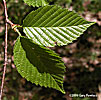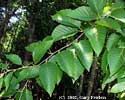
Trees of Wisconsin
| Betula
alleghaniensis Britton yellow birch Family: Betulaceae |
||||||||||||||||||
|
||||||||||||||||||
|
Leaves of Betula alleghaniensis are simple, alternate and doubly-toothed. The sap has the smell and taste of wintergreen. Mature trees of Betula alleghaniensis are unmistakeable by their papery, yellowish, often shiny bark, but seedlings and saplings can be more difficult to distinguish from other Betula species. As is the case with some other birches it tends to develop conspicuous spur branches (though not necessarily on sprouts and the fastest growing twigs). The main distribution of Betula alleghaniensis is northern, extending from Newfoundland to northern Minnesota, south through Wisconsin and Michigan to Pennsylvania, and in the Appalachian Mountains to northern Georgia. It is widely distributed in Wisconsin and is found primarily in swamps and in rich mesic forest. Unlike B. papyrifera it does very well under an established canopy and may be an important component in upland hardwood forests as well as in swamps. It also has difficulty reproducing on soils with a thick covering of dead leaves and appears to depend to some degree on establishment of seedlings on rotting stumps or logs which later rot away leaving the mature trees with "stilt" roots. Yellow birch will also sprout new stems from cut stumps. Flowers are produced in aments, the male aments longer and pendant and the female aments shorter and erect on the branches. Flowering begins about mid- to late-May in the Green Bay area.
|
|









